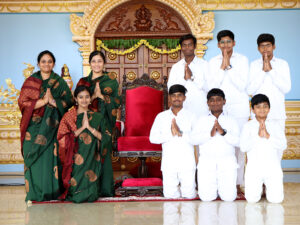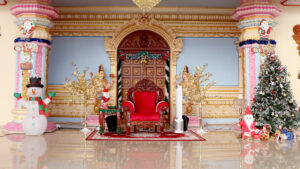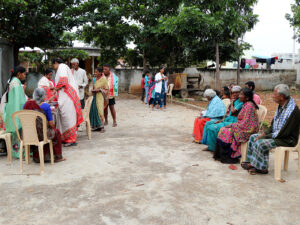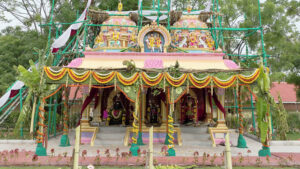The Navaratri and Dussehra celebrations at Sri Sathya Sai Vaatsalyam in Uyyamballi came alive as a vibrant tapestry of devotion, culture, and community spirit. This year’s festivities featured a rich array of events, each deeply embedded in the spiritual traditions, creating an atmosphere of profound reverence and unity.
Golu Display: A Colourful Display
The celebration commenced with the colourful and creative display of Golu dolls in the Sadashivam Hall. Meticulously arranged, this showcase featured intricately crafted dolls depicting deities and stories from Hindu mythology, depicting the ascension of man to God.


Daily Rituals: Maha Abhishekam of Vaatsalyaambika Devi and Chandika Devi
Every evening during Navaratri, the divine rituals for Vaatsalyaambika Devi and Chandika Devi would unfold with much grace and beauty. The Maha Abhishekam, Alankaram, and Kumkuma Archana were performed meticulously, with devotees engaging in prayers and singing bhajans that exalted the divine Mother. The entire hall resonated with the melodious chants of Vedas, creating an atmosphere charged with devotion.
The Abhishekam featured anointing the deities with milk, curd, ghee, honey, and a mix of fruits, alongside tender coconut, Kumkuma, Haridra Churna and Chandana. Each day, the Goddesses were beautifully draped in silk and adorned with jewellery and vibrant flowers.






The celebrations were rich in love and community spirit. Every evening, the ceremonies culminated with Kumkuma Archana accompanied by 108 chants of the Gayatri mantra, followed by offering of Prasadam, and the auspicious Maha Mangala Aarti.



Auspicious Celebrations: Divine Chants and Pujas
On the eighth day, Gana Homa was conducted to mark the beginning of special festivities. This sacred fire ritual, conducted by priests, set a tone of auspiciousness. The evening witnessed the Chandi Parayana, which enveloped the audience in spiritual bliss.




After the Abhishekam, a variety of traditional delicacies were offered to the Lord. The morning’s events concluded with maha mangala aarti and partaking of prasadam.
Chandi Homa, Durga Pooja and Lakshmi Narasimha Hrudaya Parayana
Day nine brought forth the grand Chandi Homa, where a plethora of offerings were made, culminating in the Poornahuti.






The morning celebration also included the Kanya Puja, honouring girls as embodiments of the divine feminine, and the Suhasini Puja, which revered married women as the manifestations of the divine Mother.



The evening featured the Durga Pooja, characterised by deepa and mandala decorations on the floor. Aarti was performed with devotion, symbolising love for Maa devi. This was followed by the stirring Lakshmi Narasimha Hrudaya Parayana, that enveloped the gathering in divine energy.



The Grand Finale: Vijayadashami Celebrations
The tenth day, Vijayadashami, was a grand culmination of the festivities. The Aayudha Puja honoured vehicles, symbolising devotion to service.


Kalasha Abhishekam followed next, as holy water was poured over the Goddesses, creating a sacred moment of reverence. This was followed by the final Alankaram, unveiling the Goddesses adorned in their splendid attire.


Evening Celebrations: Shubha Dayini Logo Launch and Music Programme
In the evening, the Sri Sathya Sai Shubha Dayini logo and its accompanying video were officially unveiled, representing a powerful symbol of empowerment for women and the community. This momentous reveal served as a profound reminder to honour the divine essence within each woman involved in the Shubha Dayini programme. The event was graced by all the women from the initiative, who witnessed the launch with immense pride and joy, celebrating this milestone together.


This was followed by a delightful musical programme by the Geeta Sudha team featuring enchanting songs like “Prathama Tula Vandito,” “Hamsa Vaahini Gnaana Dayini,” and “Kamale Kamalaalaye.”


The celebrations concluded with a grand Maha Mangala Aarti and distribution of Prasadam, leaving everyone with a sense of joy and fulfilment.
Conclusion: A Tapestry of Devotion and Celebration
The Navaratri and Vijayadashami celebrations at Sri Sathya Sai Vaatsalyam were not merely a series of events but a profound expression of devotion, culture, and community. Each ritual, song, and celebration reflected the essence of spirituality and collective joy, captivating all who participated in it. The festivities left a lasting impression, inspiring individuals to carry forward the spirit of Gnana Shakti, Iccha Shakti and Kriya Shakti, as represented by the divine feminine trinity of Goddesses Saraswati, Mahalaxmi and Durga, in their daily lives.










